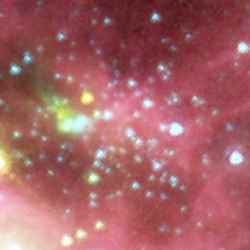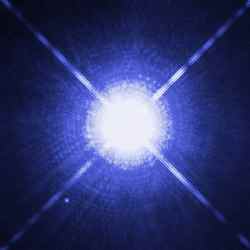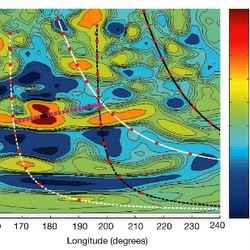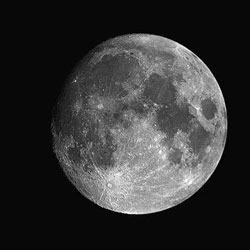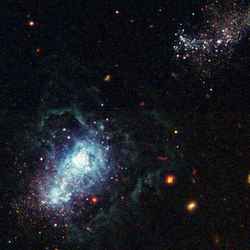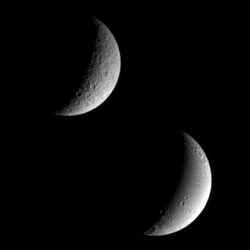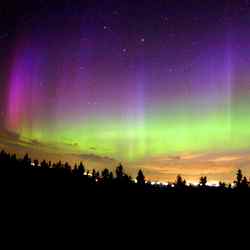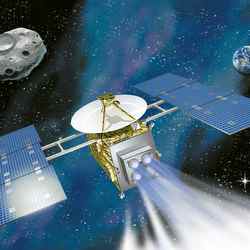
Planetary MicroBots. Image credit: NASA Click to enlarge
Interview with Penny Boston, Part I
If you want to travel to distant stars, or find life on another world, it takes a bit of planning. That’s why NASA has established NIAC, the NASA Institute for Advanced Concepts. For the past several years, NASA has been encouraging scientists and engineers to think outside the box, to come up with ideas just this side of science fiction. Their hope is that some of these ideas will pan out, and provide the agency with technologies it can use 20, 30, or 40 years down the road.
NIAC provides funding on a competitive basis. Only a handful of the dozens of proposals submitted are funded. Phase I funding is minimal, just enough for researchers to flesh out their idea on paper. If the idea shows merit, it then may get Phase II funding, allowing the research to continue from the pure-concept to the crude-prototype stage.
One of the projects that received Phase II funding earlier this year was a collaboration between Dr. Penelope Boston and Dr. Steven Dubowsky to develop “hopping microbots” capable of exploring hazardous terrain, including underground caves. If the project pans out, hopping microbots may some day be sent to search for life below the surface of Mars.
Boston spends a lot of time in caves, studying the microorganisms that live there. She is the director of the Cave and Karst Studies Program and an associate professor at New Mexico Tech in Socorro, New Mexico. Dubowsky is the director of the MIT Field and Space Robotics Laboratory at MIT, in Cambridge, Massachusetts. He is known in part for his research into artificial muscles.
Astrobiology Magazine interviewed Boston shortly after she and Dubowsky received their Phase II NIAC grant. This is the first of a two-part interview. Astrobiology Magazine (AM): You and Dr. Steven Dubowsky recently received funding from NIAC to work on the idea of using miniature robots to explore subsurface caves on Mars? How did this project come about?
Penny Boston (PB): We’ve been doing quite a lot of work in caves on Earth with an eye to looking at the microbial inhabitants of these unique environments. We think they can serve as templates for looking for life forms on Mars and other extraterrestrial bodies. I published a paper in 1992, with Chris McKay and Michael Ivanov, suggesting that the subsurface of Mars would be the last refuge of life on that planet as it became colder and drier over geological time. That got us into the business of looking into the subsurface on Earth. When we did, we discovered that there is an amazing array of organisms that are apparently indigenous to the subsurface. They interact with the mineralogy and produce unique biosignatures. So it became a very fertile area for us to study.
Getting into difficult caves even on this planet is not that easy. Translating that to robotic extraterrestrial missions requires some thought. We have good imaging data from Mars showing distinct geomorphological evidence for at least lava-tube caves. So we know that Mars has at least that one type of cave that could be a useful scientific target for future missions. It’s plausible to think that there are also other types of caves and we have a paper in press in an upcoming Geological Society of America Special Paper exploring unique cave-forming (speleogenetic) mechanisms on Mars. The big sticking point is how to get around in such rigorous and difficult terrain.
AM: Can you describe what you did in the first phase of the project?
PB: In Phase I, we wanted to focus on robotic units that were small, very numerous (hence expendable), largely autonomous, and that had the mobility that was needed for getting into rugged terrains. Based on Dr. Dubowsky’s ongoing work with artificial-muscle-activated robotic motion, we came up with the idea of many, many, tiny little spheres, about the size of tennis balls, that essentially hop, almost like Mexican jumping beans. They store up muscle energy, so to speak, and then they boink themselves off in various directions. That’s how they move.
credit:Render by R.D.Gus Frederick
Planetary Setting For Large-Scale Planetary Surface & Subsurface Exploration. Click image for larger view.
Image Credit: Render by R.D.Gus Frederick
We’ve calculated that we could probably pack about a thousand of these guys into a payload mass the size of one of the current MERs (Mars Exploration Rovers). That would give us the flexibility to suffer the loss of a large percentage of the units and still have a network that could be doing recon and sensing, imaging, and perhaps even some other science functions.
AM: How do all these little spheres co-ordinate with each other?
PB: They behave as a swarm. They relate to each other using very simple rules, but that produces a great deal of flexibility in their collective behavior that enables them to meet the demands of unpredictable and hazardous terrain. The ultimate product that we’re envisioning is a fleet of these little guys being sent to some promising landing site, exiting from the lander and then making their way over to some subsurface or other hazardous terrain, where they deploy themselves as a network. They create a cellular communication network, on a node-to-node basis.
AM: Are they able to control the direction in which they hop?
PB: We have aspirations for them ultimately to be very capable. As we move into Phase II, we’re working with Fritz Printz at Stanford on ultra-miniature fuel cells to power these little guys, which would enable them to be able to do a fairly complex array of things. One of those capabilities is to have some control over the direction in which they go. There are certain ways that they can be built that can allow them to preferentially go in one direction or another. It’s not quite as precise as it would be if they were wheeled rovers just going on a straight path. But they can preferentially cant themselves more or less in the direction that they wish to go. So we’re envisioning that they will have at least crude control over direction. But a lot of their value has to do with their swarm motion as an expanding cloud.
As wonderful as the MER rovers are, for the kind of science I do, I need something more akin to the insect robot idea pioneered by Rodney Brooks at MIT. Being able to tap into the model of insect intelligence and adaptation for exploration had long appealed to me. Adding that to the unique mobility provided by Dr. Dubowsky’s hopping idea, I think, can enable a reasonable percentage of these little units to survive the hazards of subsurface terrain – that just seemed like a magical combination to me.
HB: So in Phase I, did any of these actually get built?
PB: No. Phase I, with NIAC, is a six-months-long brain-straining, pencil-pushing study, to scope out the state of the art of the relevant technologies. In Phase II, we’re going to do a limited amount of prototyping and field-testing, over a two-year period. This is far less than what one might need for an actual mission. But, of course, that is NIAC’s mandate, to examine technology 10 to 40 years out. We’re thinking this is probably in the 10- to 20-year range.
AM: What kinds of sensors or scientific equipment do you imagine being able to put on these things?
PB: Imaging is clearly something that we would like to do. As cameras become incredibly tiny and robust, there are already units in the size range that could be mounted on these things. Possibly some of the units could be fitted with magnification capability, so one could look at the textures of the materials that they are landing on. Integrating images taken by tiny cameras on lots of different little units is one of the areas for future development. That’s beyond the scope of this project, but that’s what we’re thinking of for imaging. And then, certainly chemical sensors, being able to sniff and sense the chemical environment, which is very critical. Everything from tiny laser noses to ion-selective electrodes for gases.
We are envisioning having them not all identical, but rather an ensemble, with enough of the different kinds of units fitted out with different kinds of sensors so that the probability would still be high, even given fairly high losses of numbers of units, that we would still have a complete suite of sensors. Even though each individual unit cannot have a giant payload of sensors on it, you could have enough so that it could give significant overlap with its fellow units.
AM: Will it be possible to do biological testing?
PB: I think so. Particularly if you imagine the time frame that we’re looking at, with the advances that are coming online with everything from quantum dots to lab-on-a-chip devices. Of course, the difficulty is getting sample material to those. But when we’re dealing with little ground-contacting units like our hopping microbots, you might be able to position them directly over the material that they wish to test. In combination with microscopy and wider-field imagery, I think that the capability is there to do some serious biological work.
AM: Do you have an idea of what the milestones are that you’re hoping to hit during your two-year project?
PB: We’re anticipating that by March we may have crude prototypes that have the relevant mobility. But that may be overly ambitious. Once we do have mobile units, our plan is to do field testing in real lava-tube caves that we are doing science on in New Mexico.
The field site’s already tested. As part of Phase I the MIT group came out and I taught them a little bit about caving and what the terrain was actually like. It was a big eye-opener for them. It’s one thing to design robots for the halls of MIT, but it’s another thing to design them for real-world rocky environments. It was a very educational experience for us all. I think they have a pretty good idea what the conditions are that they have to meet with their design.
AM: What are those conditions?
PB: Extremely uneven terrain, lots of crevices that these guys could get temporarily jammed in. So we’ll need modes of operation that will allow them to extricate themselves, at least with a reasonable chance of success. The challenges of line-of-sight communication in a highly rough surface. Getting over big boulders. Getting stuck in little cracks. Things of that sort.
Lava is not smooth. The interior of lava tubes is intrinsically smooth after they’re formed, but there is a lot of material that shrinks and cracks and falls down. So there are rubble piles to get around and over, and a lot of elevational change. And these are things that conventional robots don’t have the capability to do.
Original Source: NASA Astrobiology
